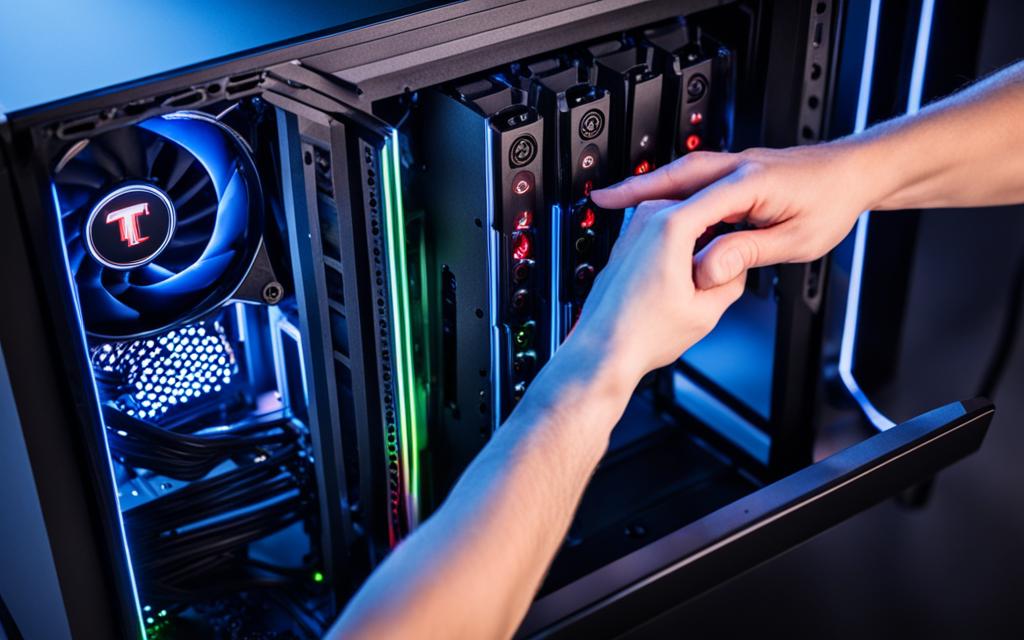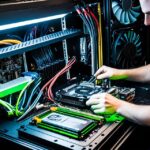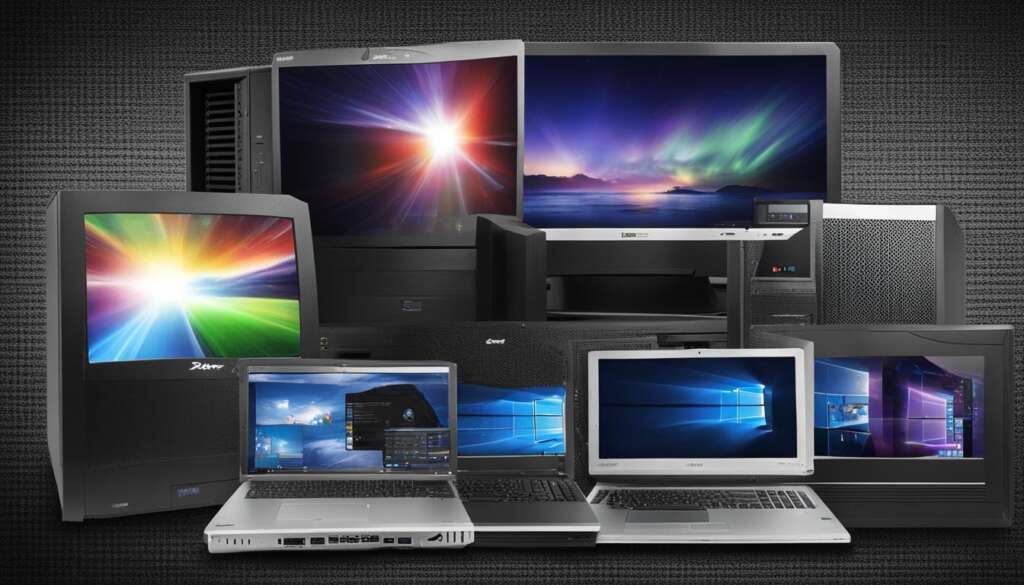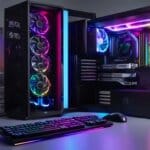Table of Contents
Building your own PC is both exciting and rewarding. In this guide, we’ll show you how to start your Thermaltake PC. These instructions cater to both beginners and those with PC building experience, ensuring a smooth start-up.
Before we begin, make sure you have chosen the right components for your Thermaltake PC. The performance of your PC heavily depends on your component choices. Research thoroughly to select components that meet your needs and fit your budget. (Source: thermaltake.com.au)
Choosing the Right Components for Your Thermaltake PC
Choosing the right parts is key to building a PC. First, think about what you want the PC to do. Are you creating a gaming rig, a workstation, or a general-use computer? Identify your needs, then pick suitable components like the motherboard, CPU, RAM, storage, and power supply. It’s crucial to select components that work well together and meet your requirements. (Source: thermaltake.com.au)
Steps to Assemble Your Thermaltake PC
To start assembling your Thermaltake PC, prepare the case. This means opening it, putting in motherboard standoffs, and fitting the I/O plate. Then, secure the power supply at the case’s upper back with four screws. Make sure to install the motherboard properly, checking that all connections are tight and BIOS settings are correct. (Source: thermaltake.com.au1)
Now with the motherboard installed, add the CPU, RAM, storage devices, and GPU. Each part must be installed with care to work well. Manage the cables neatly inside to maintain a tidy setup and ensure airflow isn’t blocked. Double-check all connections are secure before moving on. (Source: thermaltake.com.au)
Finalizing Your Thermaltake PC Build
With all parts in place, it’s time to complete your Thermaltake PC build. Now, connect any extra components like speakers, a floppy drive, and a video card. These enhance your PC but aren’t necessary for it to run. Make sure all cables are correctly and securely connected. (Source: thermaltake.com.au1)
Powering On Your Thermaltake PC
With your PC assembled, it’s time to switch it on. Connect the power and plug it in. Check that cables are correct and fans or vents are clear before you power up. Press the power button and listen for your PC starting. If there are any issues, check the troubleshooting guide for help. (Source: thermaltake.com.au12)
Conclusion
Creating your Thermaltape PC is an enriching experience. This guide has shown you how to pick components and put together your PC. With careful attention, you can build a bespoke computer that suits your unique requirements. Enjoy your Thermaltake PC building journey!
Key Takeaways
- Choosing suitable parts is essential for your Thermaltake PC. Think about your specific needs and budget when picking components. (Source: thermaltake.com.au)
- To assemble your Thermaltake PC correctly, follow the instructions for case preparation, power supply, motherboard, and other part installations. (Source: thermaltake.com.au1)
- Before switching on your Thermaltake PC, ensure all cables are properly connected. Use the guide for troubleshooting any issues at startup. (Source: thermaltake.com.au12)
Choosing the Right Components for Your Thermaltake PC
Before you start building your Thermaltake PC, choosing the right components is key. These components will decide your system’s speed, power, and what it can do. Let’s look at what to think about when picking parts for your Thermaltake PC.
CPU and RAM
The CPU and RAM are like the heart and brain of your PC. A great choice is the AMD Ryzen 7 3700X processor. It has 8 cores and can handle lots of tasks at once3. Pair it with 4 by 8 GB Crucial Ballistix RGB RAM for top speed and reliability. You can find new DDR4 RGB RAM that works just as well for around $150 or less on Amazon3.
Storage and Graphics
Fast and big storage is key for a smooth-running PC. The 1TB WD BLACK SN850X SSD is a great deal at $1003. Pair it with the EVGA FTW3 3090 graphics card for $5003 to get amazing visuals that work well with the AMD processor.
Motherboard and Case
Choosing the right motherboard is crucial. The ASUS ROG Strix Z590-A motherboard is a smart pick at $1503. It’s great for your PC build. For the case, the Lian Li 011 Dynamic XL or Corsair 4000x and 5000x are nice choices. They have glass panels to show off your PC and lots of room for cooling and customizing3.
Power Supply and Cooling
A 1000 watt EVGA supernova power supply is a good choice for enough power3. It’s reliable and stable. For cooling, Lian Li Uni Fans are recommended, and you’ll need about 9 fans costing $2303. They help keep your system cool, even when it’s working hard.
Components and Case Size
Your components need to fit inside your case. Full tower cases are big and great for high-end builds4. They can hold larger parts and more cooling gear. Mid-tower cases are smaller but can still fit ATX motherboards4. For tiny PCs, mini-ITX cases are best, but remember they need good cooling4.
Power Supply Efficiency and Cable Management
For your power supply, get one with a high efficiency rating like 80 PLUS Platinum5. They use less power and make less heat. Look for one that offers enough power and is modular for easier cable management5.
Good cable management makes your PC look neat and improves airflow4. Find a case with cut-outs for hiding cables. It makes your build look better and work better.
Now you know what to look for in Thermaltake PC components. Pick parts that meet your needs, fit your budget, and give the performance you want. Have fun building a powerful and good-looking PC.
| Component | Price |
|---|---|
| AMD Ryzen 7 3700X Processor | $328 |
| Crucial Ballistix RGB RAM (4x8GB) | $1003 |
| WD BLACK SN850X SSD (1TB) | $1003 |
| EVGA FTW3 3090 Graphics Card | $5003 |
| ASUS ROG Strix Z590-A Motherboard | $1503 |
| Lian Li Uni Fans Pack (9 Fans) | $2303 |
| 1000W EVGA Supernova Power Supply | Varies |
Steps to Assemble Your Thermaltake PC
Are you ready to start building your Thermaltake PC? With all your parts in place, let’s dive into the assembly process. Follow the steps below carefully to make sure your PC build is successful and works great.
- First, put the motherboard in the case. Make sure it lines up with the standoffs and screw it in firmly. This step creates a solid base for your PC6.
- Now, put in the CPU and its cooler. Remember to take off any covers and put thermal paste on for better cooling6. A screwdriver will help you secure the cooler properly6.
- Next, slot in the RAM sticks in their correct places on the motherboard. Make sure they click in place for the best performance6.
- Then, install the graphics card in the right PCIe slot. It will power through games and any task that needs lots of graphics power7.
- It’s time for the power supply. Pick a strong one, like the 750W RGB from Thermaltake. Connect all the cables to the motherboard to give your PC the power it needs7.
- Add extra storage with HDDs or SSDs based on how much space you need7.
- Good cable management makes your PC look neat and helps with airflow. Use ties to organize your cables well7.
- To keep your PC cool, consider adding more fans. Position the front fans to bring in air and the top/back fans to push air out. This setup will help keep everything cool8.
By sticking to these steps and choosing the right parts, your Thermaltake PC will not only look good but also run smoothly. Check the manuals or online for help with your specific parts and motherboard. If you get stuck, help is just a forum away8.
Keep an eye out for our next section. We’ll add the final touches to your Thermaltake PC.
Finalizing Your Thermaltake PC Build
After assembling your Thermaltake PC, it’s crucial to wrap things up. You need to make sure every piece works great together. Check these steps to perfect your PC.1. Double-Check ConnectionsTake a moment to check all the connections inside your PC. Make sure every cable is tightly and correctly connected.
This means power, data, and peripheral cables. Proper connections can prevent problems later.
Powering On Your Thermaltake PC
After building your PC, it’s time to turn it on. Plug it into a power source and hit the power button on the case. You’ll likely see the Thermaltake logo appear on your screen.
Initially, the PC might run a self-check called Power On Self Test (POST). This checks if the hardware works well. If all is good, you can enter the BIOS settings to start setting up.
Thermaltake power supplies get mixed reviews. Yet, some people have used them for years without issues. For instance, a Thermaltake TPG-850M has worked well for 5 years. Another example is a Thermaltake 650 watt (Earthwatts EA-650) that has been running smoothly since Oct 20119.
Turning on a Thermaltake PC can lead to questions. An online chat from February 2019 about this topic got 5K views, 19 replies, and 12 participants9. This shows many people are keen to learn about the process.
Choosing the right power supply brand for your Thermaltalk PC is crucial. Other good brands include Seasonic, Corsair, EVGA, and SilverStone9. Products like the Seasonic Focus and Corsair CX are highly praised by users9.
Understanding the PSU’s Original Equipment Manufacturer (OEM) is key for quality assurance9. Knowing the OEM helps in choosing a dependable power supply for your PC.
Starting up a newly built Thermaltake PC is a landmark event. Whether you’re experienced or new, this moment is thrilling yet a bit scary. But with the correct knowledge, you’ll find it a breeze, promising a great start for your PC.
Conclusion
Building your own Thermaltake PC can be a great journey. It lets you tailor your system to meet your own needs. This step-by-step guide has aimed to get you to a fully working Thermaltake PC. Make sure to check the manuals and guides for your chosen parts for more detailed instructions10.
The Thermaltake The Tower 500 is a standout computer case. It blends eye-catching design, large size, and top-quality materials. It fits high-end parts like extended ATX motherboards, large GPUs, and big CPU coolers10. Its design aids in neat cable management, thanks to a 20.0cm space for the power supply10. Plus, it has enough room for many cooling systems. It supports tall CPU coolers up to 275mm and graphics cards up to 325mm with its cover on1011.
The Tower 500 is quite silent, even when it’s working hard, scoring 3.0/10 for noise10. Thermaltake also adds brackets inside for more radiators and fans. This means better water cooling10. It also has plenty of grommeted holes for hiding cables, making cable management easier10.
Although the Thermaltake The Tower 500 has a high price tag of $180, it delivers outstanding features and quality10. With its stunning looks, efficient design, and strong build, the Thermaltake The Tower 500 is a great choice for those wanting a top-notch and attractive PC10.
FAQ
Can I use any CPU, motherboard, RAM, power supply, graphics card, and storage for my Thermaltake PC?
Choosing the right components is key. Make sure they all work well together and meet your needs. Think about the brand, how they fit together, and how you’ll keep everything cool.
Do I need to install case fans for my Thermaltake PC?
Yes, adding case fans helps cool down your PC. Just make sure to connect them properly to your motherboard.
How can I improve cable management in my Thermaltake PC?
For better cable management, tidy up cables with ties. This improves airflow and makes your PC look great.
What should I do after assembling my Thermaltake PC?
After assembly, check all connections. Organise your cables neatly, then put the case parts back on.
What should I expect during the first boot of my Thermaltake PC?
Your PC will check its hardware when you first start it. If all is well, you’ll enter the BIOS to set things up.
How can building my own Thermaltake PC benefit me?
Creating your Thermaltake PC lets you tailor it to your liking. It’s rewarding and delivers a unique, powerful computer.
Source Links
- https://www.instructables.com/Build-a-PC/ – Build a PC
- https://forums.tomshardware.com/threads/computer-not-booting.571452/ – Computer not booting
- https://signalrgb.com/blog/synced-rgb-pc-build-guide/ – SignalRGB
- https://www.digitaltrends.com/computing/pc-case-buying-guide/ – How to pick the best PC case for your needs in 2023 | Digital Trends
- https://www.intel.com/content/www/us/en/gaming/resources/power-supply.html – How to Choose Power Supply for PC: What to Know – Intel
- http://www.mysuperpc.com/pc_assembly/computer_install_cpu_cooler.shtml – My Super PC – Computer Assembly – How To Assemble A PC Guide
- https://www.tomshardware.com/reviews/thermaltake-the-tower-100-review/2 – Thermaltake The Tower 100 Review: Affordable ITX Weirdness
- https://blog.thermaltake.com.au/2019/09/how-to-build-a-pc/ – How to Build your first PC | Thermaltake Blog
- https://www.overclock.net/threads/is-thermaltake-a-reputable-brand-for-a-power-supply.1715224/ – Is Thermaltake a reputable brand for a Power supply?
- https://aphnetworks.com/reviews/thermaltake-the-tower-500/4 – Thermaltake The Tower 500 Review (Page 4 of 4)
- https://www.overclockersclub.com/guides/atx_psu_startup/ – How To Turn On An ATX Power Supply Without A Motherboard












